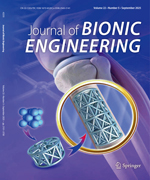|
|
Systematic Review on Wearable Lower Extremity Robotic Exoskeletons for Assisted Locomotion
Shuang Qiu, Zhongcai Pei, Chen Wang & Zhiyong Tang
Journal of Bionic Engineering. 2023, 20 (2):
436-469.
DOI: 10.1007/s42235-022-00289-8
Lower extremity robotic exoskeletons (LEEX) can not only improve the ability of the human body but also provide healing treatment for people with lower extremity dysfunction. There are a wide range of application needs and development prospects in the military, industry, medical treatment, consumption and other fields, which has aroused widespread concern in society. This paper attempts to review LEEX technical development. First, the history of LEEX is briefly traced. Second, based on existing research, LEEX is classified according to auxiliary body parts, structural forms, functions and fields, and typical LEEX prototypes and products are introduced. Then, the latest key technologies are analyzed and summarized, and the research contents, such as bionic structure and driving characteristics, human–robot interaction (HRI) and intent-awareness, intelligent control strategy, and evaluation method of power-assisted walking efficiency, are described in detail. Finally, existing LEEX problems and challenges are analyzed, a future development trend is proposed, and a multidisciplinary development direction of the key technology is provided.
Related Articles |
Metrics
|

 Table of Content
Table of Content
 Table of Content
Table of Content